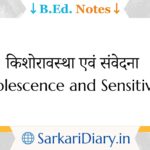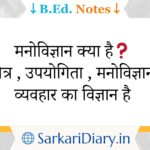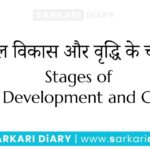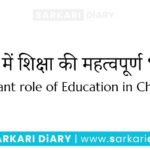From 1951-52 to 1967, elections to the Lok Sabha and State Legislative Assemblies were held mostly simultaneously and thereafter the cycle was broken and now, elections are held almost every year and even at different times within a year. , resulting in huge expenditure by the Government and other stakeholders, deployment of security forces and other election officials deployed in such elections for significantly longer periods other than their core duties, prolonged enforcement of Model Code of Conduct, etc. Due to residence, development occurs in the form of interruptions in work for long periods;
The Law Commission of India, in its 170th Report on Reforms in Electoral Laws, has observed that: “The cycle of holding elections every year and without appropriate time should be abolished. We should look back at the earlier situation where the people Elections to the House and to all the Legislative Assemblies are held simultaneously. It is true that we cannot envisage or provide for all situations or possibilities, whether by reason of the application of Article 356 (which has been substantially reduced after the Supreme Court’s decision in S.R. Bommai vs. Union of India) or may arise for any other reason, holding separate elections for a Legislative Assembly should be an exception and not the rule. There should be ‘one election for the Lok Sabha and all the Legislative Assemblies once in five years’.” ,
The Parliamentary Standing Committee on Department of Personnel, Public Grievances, Law and Justice, in its 79th Report on ‘Feasibility of holding simultaneous elections to the House of the People and State Legislative Assemblies’ submitted in December 2015, has also examined the matter and made two observations. Recommends an alternative and viable method of conducting simultaneous elections in phases;
Therefore, now in view of the aforesaid and in the national interest, it is desirable to hold simultaneous elections, the Government of India is pleased to appoint a high level committee (hereinafter referred to as) to examine the issue of simultaneous elections and to hold simultaneous elections in the country. referred to as ‘HLC’].
Concept of One Nation, One Election (ONOE) in India
Proponents of the One Nation, One Election concept argue that it will bring about several benefits for India. Firstly, it is believed that simultaneous elections will reduce the massive expenditure associated with conducting separate elections. Currently, political parties and candidates spend exorbitant amounts of money on campaigning and advertising during elections. With ONOE, the frequency of elections will be reduced, leading to substantial cost savings for both the government and political parties.
In addition to financial benefits, the concept of ONOE also aims to bring stability to India’s political landscape. Currently, elections are held at different times for the central government and each state government, resulting in a perpetual election cycle. This not only diverts the attention of politicians away from governance but also disrupts the functioning of the government machinery. By synchronizing elections, the focus of politicians can shift towards policy-making and governance, leading to more effective and efficient administration.
Furthermore, proponents argue that ONOE will help curb the influence of money and muscle power in elections. Currently, political parties often resort to unethical practices to win elections, including bribing voters and using muscle power to intimidate opponents. With simultaneous elections, the time period for such malpractices will be reduced, making it harder for parties to manipulate the electoral process. This will promote a fair and level playing field for all candidates and parties, ensuring that elections are truly democratic.
However, there are also critics of the One Nation, One Election concept. One major concern is that it may undermine the federal structure of India’s democracy. India is a diverse country with varied regional issues and interests. Holding simultaneous elections may result in the dominance of national issues and neglect of regional concerns. Critics argue that state-level elections allow for a more nuanced understanding of local issues and the election of representatives who can effectively address them.
Another concern raised by opponents is the impact of ONOE on smaller regional parties. Simultaneous elections may disadvantage smaller parties that lack the resources and organizational capacity to contest elections on a national scale. This could lead to the marginalization of regional parties and a consolidation of power in the hands of national parties, potentially undermining the representation of diverse voices and perspectives in the political arena.
In conclusion, the concept of One Nation, One Election has both advantages and disadvantages. While it aims to bring financial savings, stability, and fairness to the electoral process, it also raises concerns about the federal structure of India’s democracy and the representation of regional parties. As the debate continues, it is crucial to carefully consider the implications of ONOE and find a balanced approach that ensures the integrity of India’s democratic system while addressing the challenges posed by frequent elections.
The Need for One Nation, One Election
The proponents of the ONOE concept argue that it will bring about several benefits for the country. Firstly, it is believed that simultaneous elections will reduce the massive expenditure involved in conducting separate elections at different times. This would result in substantial cost savings, which could be utilized for developmental purposes.
Secondly, the frequent cycle of elections in India often leads to a halt in the functioning of the government machinery. As election campaigns take precedence, policy implementation and decision-making take a backseat. By having one-time elections, the government can focus on governance without constant interruptions.
Thirdly, the ONOE concept is seen as a way to curb the influence of money and muscle power in elections. With simultaneous elections, the duration of the election process will be shorter, reducing the scope for illegal activities and corruption.
Furthermore, proponents argue that ONOE will enhance political stability and continuity. Currently, with elections taking place at different times, there is a constant state of campaigning and political uncertainty. This not only affects the functioning of the government but also hampers long-term planning and policy implementation. By having one-time elections, the government can have a fixed term, allowing for better governance and stability.
In addition, ONOE can also lead to increased voter participation. With multiple elections happening at different times, voter fatigue often sets in, and people may become disinterested or overwhelmed. However, by having simultaneous elections, it can create a sense of unity and collective responsibility among voters, encouraging them to actively participate in the democratic process.
Moreover, ONOE can also address the issue of regional parties dominating state-level politics. With simultaneous elections, the focus shifts from regional issues to national issues, allowing for a more balanced representation and a broader perspective in decision-making.
Lastly, ONOE can streamline the election process and reduce administrative burdens. Currently, the Election Commission has to conduct elections in various states at different times, which requires extensive planning, resources, and manpower. By having one-time elections, the logistical challenges can be minimized, allowing for a more efficient and effective election process.
Additionally, the financial implications of One Nation, One Election cannot be overlooked. Conducting elections is an expensive affair, and holding simultaneous elections would significantly increase the financial burden on the government. The cost of campaigning, security arrangements, and other logistical expenses would escalate exponentially. It is imperative to carefully analyze the financial feasibility of implementing this concept and explore ways to manage the increased costs.
Moreover, the concept of simultaneous elections raises questions about the role of the opposition in a democratic system. Elections provide an opportunity for the opposition parties to hold the ruling party accountable and present alternative policies and ideas to the public. With simultaneous elections, the opposition might not have sufficient time to prepare and effectively challenge the ruling party. This could potentially weaken the democratic process and limit the space for political dissent and debate.
Furthermore, the issue of voter fatigue cannot be ignored. Elections are a time-consuming process for both voters and political parties. Holding frequent elections at different levels can lead to voter exhaustion and disengagement. Simultaneous elections might exacerbate this problem, as voters would be bombarded with a plethora of candidates and campaigns all at once. It is crucial to consider the impact of simultaneous elections on voter participation and ensure that citizens have adequate time and information to make informed decisions.
Lastly, the constitutional implications of One Nation, One Election need careful examination. The Constitution of India provides for staggered elections to ensure the smooth functioning of the democratic system. Any changes to this established practice would require constitutional amendments and thorough deliberation. It is essential to ensure that the principles of democracy, representation, and accountability are not compromised in the pursuit of synchronization.
In conclusion, while the concept of One Nation, One Election offers potential benefits such as reducing election expenditure and ensuring stable governance, it is essential to address the challenges and concerns associated with its implementation. Striking a balance between the principles of federalism, financial feasibility, opposition role, voter fatigue, and constitutional implications is crucial to ensure the success and legitimacy of simultaneous elections in India.
The Way Forward
Implementing the concept of One Nation, One Election in India requires careful deliberation and consensus-building among all stakeholders. It is essential to address the concerns and challenges associated with the concept while keeping in mind the principles of federalism and the democratic spirit of the country.
One possible approach could be to conduct pilot projects in select states to test the feasibility and effectiveness of simultaneous elections. This would provide valuable insights and help in refining the process before scaling it up to a national level.
Additionally, it is crucial to create awareness among the general public about the benefits and implications of One Nation, One Election. A well-informed citizenry can actively participate in the discourse and contribute to shaping the future of the electoral system in the country.
In order to create this awareness, the government and other relevant organizations can launch educational campaigns, utilizing various mediums such as television, radio, social media, and community engagement programs. These campaigns can highlight the advantages of simultaneous elections, such as reduced election expenditure, increased governance efficiency, and the prevention of frequent disruptions caused by election cycles.
Furthermore, it is important to address the concerns raised by political parties and regional leaders regarding the potential loss of autonomy and dilution of regional issues. This can be achieved by ensuring that the federal structure of the country is respected, and that the unique needs and aspirations of each state are taken into account during the election process.
Another aspect that needs to be considered is the legal framework for implementing One Nation, One Election. Amendments may be required in the Representation of the People Act, 1951, and other relevant laws to facilitate the synchronization of elections at various levels. This would require a comprehensive and inclusive discussion among legal experts, policymakers, and representatives from different political parties.
In conclusion, the concept of One Nation, One Election has the potential to bring about significant changes in the electoral landscape of India. However, its implementation requires careful consideration of the challenges and concerns associated with it. With a balanced approach and active participation from all stakeholders, India can move towards a more synchronized and efficient electoral system. The success of this endeavor will depend on the willingness of political leaders to set aside their differences and work towards the greater good of the nation. Only through collective efforts can India overcome the hurdles and realize the vision of One Nation, One Election.








